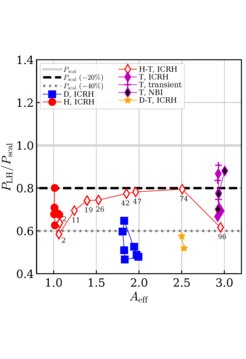Unexpected isotopic dependence of access threshold found for high energy confinement plasmas
Unique experiments with plasmas containing tritium at the JET fusion facility in Culham, UK, show that plasmas made from mixtures of hydrogen isotopes behave differently from isotopically pure plasmas of the same isotopic weight.

In experiments at the JET fusion facility, IPP scientists have investigated the isotope dependence of the power threshold for achieving plasmas with high energy confinement, the so-called H-mode. Among other things, this is important for estimating the amount of heating power required in a fusion power plant. In very rare experiments using plasmas with tritium (superheavy hydrogen), it was shown that it makes a difference whether one wants to achieve H-mode in a plasma of pure deuterium (D) or a mixture of hydrogen and tritium (H-T), although both plasmas have the same effective isotope mass Aeff. This was not expected on the basis of past experiments and could be explained by the fact that the heat transport before the transition to the H-mode also depends not only on the isotopic mass but on the concrete isotopic composition, as explained in a recent publication, see G. Birkenmeier et al, Plasma Phys. Control. Fusion 65 054001 (2023)
https://iopscience.iop.org/article/10.1088/1361-6587/acc423/meta
